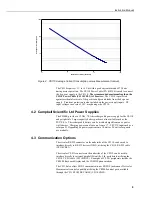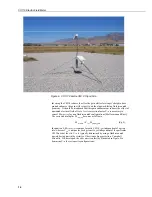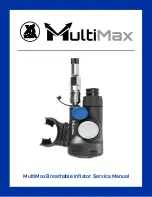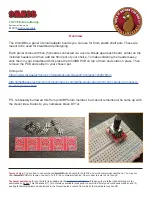
Instruction Manual
23
The CR1000 differential voltage measurement (
VoltDiff
) instruction is given as
follows:
VoltDiff(
Dest,Reps,Range,DiffChan,RevDiff,Settling Time,Integ,Mult,Offset
)
where
Dest
is the destination variable of the result.
Reps
is the number of times to
repeat a given measurement on successive channels,
Range
is one of
±
5000 mV,
±
2500 mV,
±
250 mV,
±
25 m,
±
7.5 mV, or
±
2.5 mV input voltage ranges available
on the CR1000.
DiffChan
is the appropriate differential input channel (1 – 8).
RevDiff
is a true or false parameter to determine whether or not to perform two
successive differential measurements with reversed input polarity, in order to
reduce low-frequency measurement errors.
Settling Time
is a parameter allowing
extra input settling time for “slow” settling sensors.
Integ
is a parameter
indicating the length of time to perform an analogue integration during the
measurement, with options of 250
μ
s, _50Hz and _60Hz. Integration times for
_50Hz and _60Hz are 20 ms and 16.67 ms, respectively for cancellation of
unwanted 50 Hz and 60 Hz noise.
Mult
provides for scaling within the
measurement instruction, while
Offset
provides for the incorporation of offsets.
Single-ended voltage measurements are referenced to ground, rather than the low
side of a differential input. The
VoltSE
single-ended measurement instruction is
quite similar to the
VoltDiff
instruction and is given as follows:
VoltSe (
Dest,Reps,Range,SEChan,MeasOff,Settling Time,Integ,Mult,Offset
)
An internal ground reference is utilized in single-ended measurements. Single-
ended offset errors are reduced in single-ended measurements by measuring the
voltage on the internal ground reference. The
MeasOff
parameter in the
VoltSe
instruction determines if this internal ground reference is measured at the
beginning of every
VoltSe
instruction (
MeasOff
= True) or whether a single-
ended offset voltage measure is performed as part of an on-going instrument self-
calibration routine occurring in background (
MeasOff
= False).
Another general purpose voltage measurement instruction is the
BrHalf
instruction, which provides voltage excitation for a simple resistive divider (half
of a 4-element Wheatstone bridge), and then measures the resulting voltage.
A
BrHalf
instruction follows:
BrHalf (
Dest,Reps,Range,SEChan,ExChan,MeasPEx,ExmV,RevEx,Settling
Time,Integ,Mult,Offset
)
Most parameters of the
BrHalf
instruction are common to the
VoltDiff
and
VoltSE
instructions, and so only the differences will be discussed. The
ExChan
parameter determines which one of the three CR1000 voltage excitation outputs
are used to excite the half-bridge.
MeasPEx
determines how many successive
channels are excited by the same excitation channel in successive
Reps
.
ExmV
determines the excitation voltage which can range from –2500 mV to +2500 mV.
RevEx
is a true/false parameter and if true then the polarity of the excitation is
reversed during the measurement and a second measurement taken. Like input
reversal on differential measurements, excitation reversal is an error cancelling
technique for reducing low-frequency measurement errors such as offset voltages.
The
Battery
instruction is used to measure the input voltage of the power supply
to the CS110 and follows:
Battery (
Dest
)
The
PanelTemp
instruction is used to measure the temperature of a thermistor
located within the CS110 case and follows:
Summary of Contents for CS110
Page 2: ......
Page 4: ......
Page 6: ......
Page 10: ...iv This is a blank page ...
Page 37: ...Instruction Manual 27 ...
Page 48: ......
Page 52: ...Appendix B CS110 Accessories This is a blank page B 2 ...
Page 56: ...Appendix C CS110 Connector Pin outs C 4 This is a blank page ...
Page 72: ...Appendix F Example CRBasic Programs This is a blank page F 4 ...
Page 78: ...Appendix G CS110 2 Metre CM10 Tripod Site This is a blank page G 6 ...
Page 85: ......
















































